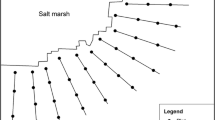Abstract
The zonation of different Salicornia species within saltmarshes has been described controversially in prior publications. The aim of this study is to detect substantial relations between pedological conditions and the distribution of different Salicornia species (Salicornia stricta Dumort. 1868, Salicornia europaea L. 1753, and Salicornia procumbens Sm 1813). 37 sites were investigated regarding vegetation pattern, soil morphology and physicochemical and chemical soil properties. A multivariate approach indicate a clear differentiation of the sites dominated by different Salicornia species in respect to sand content, redox potential and water content. However, results of a detailed statistical assessment indicate that redox potential and salinity are the most relevant parameters. Salicornia stricta sites are characterized by a variety of grain sizes, reduced conditions in the rhizosphere, highest water contents (median: 71.5 Vol-%) and lowest Eh values (median: −19.0 mV), indicating the best adaptation to anaerobic soil conditions. Salicornia procumbens occurs on aerated soils (median Eh: 455.6 mV) with high sand contents independent to position relative to mean high tide level. Exhibiting the lowest (11.5‰) and highest soil salinities (41.7‰), even developing in salt pans (136‰), Salicornia europaea feature a great ecological amplitude regarding temporal variations of salinity. These findings underline the ecotypic and phenotypic plasticity of Salicornia species and offer a promising approach for further experimental settings focussing on phenotypic adaptions and ecological amplitudes of Salicornia taxa and ecotypes.



Similar content being viewed by others
References
Aghaleh M, Niknam V, Ebrahimzadeh H, Razavi K (2011) Effect of salt stress on physiological and antioxidative responses in two species of Salicornia (S. persica and S. europaea). Acta Physiol Plant 33:1261–1270. doi:10.1007/s11738-010-0656-x
Ball PW, Tutin TG (1959) Notes on annual species of Salicornia in Britain. Watsonia 4:193–205
Bloem E, Lüttmann B, Giani L (1995) Jahreszeitliche Schwefeldynamik semisubhydrischer Salzmarschen. Z Pflanzenernähr Bodenkd 158:251–256. doi:10.1002/jpln.19951580307
Boden A-h-AG (2005) Bodenkundliche Kartieranleitung, 5th edn. Schweitzerbart’sche Verlagsbuchhandlung, Stuttgart
Davy AJ, Bishop GF, Costa CSB (2001) Salicornia L. (Salicornia pusilla J. Woods, S. ramosissima J. Woods, S. europaea L., S. obscura P.W. Ball & Tutin, S. nitens P.W. Ball & Tutin, S. fragilis P.W. Ball & Tutin and S. dolichostachya Moss). J Ecol 89:681–707. doi:10.1046/j.0022-0477.2001.00607.x
Egan TP, Ungar IA (2001) Competition between Salicornia europaea and Atriplex prostrata (Chenopodiaceae) along an experimental salinity gradient. Wetl Ecol Manag 9:457–461. doi:10.1023/a:1012276510818
Ellenberg H (1986) Vegetation Mitteleuropas mit den Alpen, 4th edn. Ulmer, Stuttgart
Giani L, Keuchel B, Nay M, Widzgowski S (1993) Periodische und aperiodische Veränderungen in den Eigenschaften junger Marschböden im Deichvorland. Z Pflanzenernähr Bodenkd 156:323–331. doi:10.1002/jpln.19931560409
Hulisz P, Piernik A, Mantilla-Contreras J, Elvisto T (2016) Main driving factors for seacoast vegetation in the southern and eastern baltic. Wetlands 36:909–919. doi:10.1007/s13157-016-0803-2
IUSS Working Group WRB (2014) World reference base for soil resources 2014. International soil classification system for naming soils and creating legends for soil maps. World Soil Resources Reports No. 106. FAO, Rome
Kadereit G et al (2007) A taxonomic nightmare comes true: phylogeny and biogeography of glassworts (Salicornia L., Chenopodiaceae). Taxon 56:1143–1170. doi:10.2307/25065909
Kadereit G, Piirainen M, Lambinon J, Vanderpoorten A (2012) Cryptic taxa should have names: reflections in the glasswort genus Salicornia (Amaranthaceae). Taxon 61:1227–1239
Katschnig D, Broekman R, Rozema J (2013) Salt tolerance in the halophyte Salicornia dolichostachya Moss: growth, morphology and physiology. Environ Exp Bot 92:32–42
Konert M, Vandenberghe JEF (1997) Comparison of laser grain size analysis with pipette and sieve analysis: a solution for the underestimation of the clay fraction. Sedimentology 44:523–535. doi:10.1046/j.1365-3091.1997.d01-38.x
König D (1960) Beiträge zur Kenntnis der deutschen Salicornien. Mitteilung der Floristisch-soziologischen Arbeitsgemeinschaft 8:5–58
Loizeau JL, Arbouille D, Santiago S, Vernet JP (1994) Evaluation of a wide range laser diffraction grain size analyser for use with sediments. Sedimentology 41:353–361. doi:10.1111/j.1365-3091.1994.tb01410.x
Oberdorfer E (2001) Pflanzensoziologische Exkursionsflora für Deutschland & angrenzende Gebiete, 8th edn. Ulmer, Stuttgart
Oksanen J, et al (2015) vegan: community ecology package, 2.2-1 edn
Pott R (1995) Farbatlas Nordseeküste und Nordseeinseln. Ulmer, Stuttgart
Pribyl DW (2010) A critical review of the conventional SOC to SOM conversion factor. Geoderma 156:75–83
R Core Team (2014) R: a language and environment for statistical computing, 303rd edn. R Foundation for Statistical Computing, Vienna
Rozema J, Van der List JC, Schat H, van Diggelen J, Broekman RA (1987) Ecophysiological response of Salicornia dolichostachya and Salicornia brachystachya to seawater inundation. In: Huiskes AHL, Blom CWPM, Rozema J (eds) Vegetation between land and sea: structure and processes. Springer Netherlands, Dordrecht, pp 180–186. doi:10.1007/978-94-009-4065-9_14
Schlichting E, Blume H-P, Stahr K (1995) Bodenkundliches Praktikum. Pareys Studientexte, vol 81, 2nd edn. Blackwell Wiss.- Ver, Berlin
Schroeder D, Brümmer G (1969) Beiträge zur Genese und Klassifizierung der Marschen. I. Problematik der Marschen-Genese und -Klassifizierung und Untersuchungen zum Ca/Mg-Verhältnis. Zeitschrift für Pflanzenernährung und Bodenkunde 122:228–249. doi:10.1002/jpln.19691220305
Teege P, Kadereit JW, Kadereit G (2011) Tetraploid European Salicornia species are best interpreted as ecotypes of multiple origin. Flora - Morphology, Distribution, Functional Ecology of Plants 206:910–920
Van Reeuwijk LP (2002) Procedures for soil analysis, 6th edn. ISRIC, Wageningen
Vernberg FJ (1993) Salt-marsh processes: a review. Environ Toxicol Chem 12:2167–2195. doi:10.1002/etc.5620121203
Wisskirchen R, Haeupler H (1998) Standardliste der Farn- und Blütenpflanzen Deutschlands. Ulmer, Stuttgart
Acknowledgments
This work has been supported by funds of the Lower Saxon Wadden Sea National Park Authority.
Author information
Authors and Affiliations
Corresponding author
Rights and permissions
About this article
Cite this article
Witte, S., Freund, H., Buhk, N. et al. Impact of pedological conditions on the distribution of Salicornia species (Southern North Sea coast). J Coast Conserv 22, 79–85 (2018). https://doi.org/10.1007/s11852-016-0487-z
Received:
Revised:
Accepted:
Published:
Issue Date:
DOI: https://doi.org/10.1007/s11852-016-0487-z




